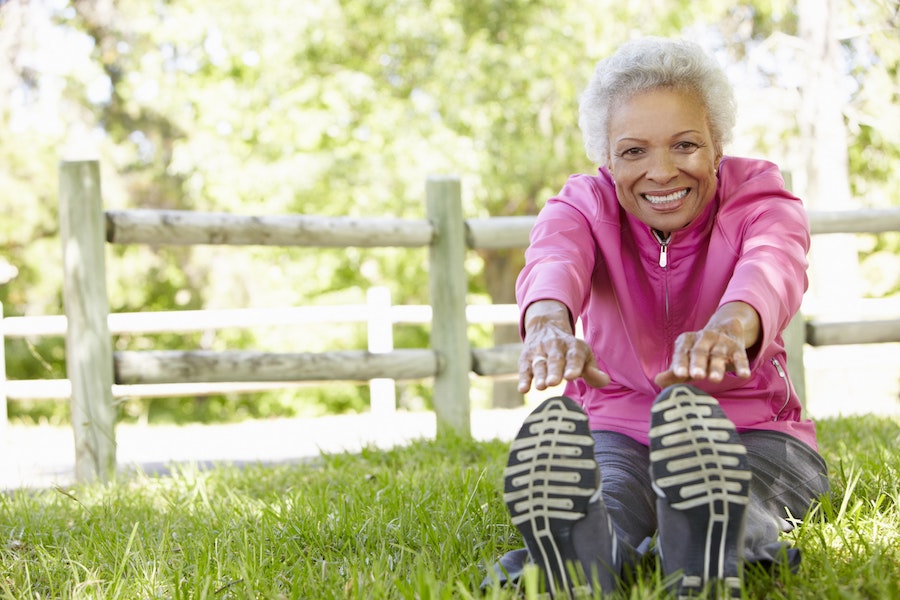6 simple but essential exercises for older people
As we grow older, niggling aches and pains can be seen as a sign it’s time to slow down and take things easy. But slowing down too much can do more harm than good.
The Chartered Society of Physiotherapy (CSP; csp.org.uk) points out that movement keeps muscles strong and helps maintain a healthy weight, which also protects the joints as we age. While it might feel like movement is the last thing you need when aches set in, regular activity can actually help manage joint stiffness, pain and fatigue, which can affect mood and mental health and wellbeing too. Keeping active can also cut the risk, or help manage, conditions like heart disease and stroke, certain cancers and type 2 diabetes.
Despite this, nearly a quarter (24%) of over-65s do no strengthening activities at all, putting them at increased risk of falls and other health problems, according to CSP research.

Keeping active and strong can help in managing joint pain
“Movement is essential for every aspect of our health. Our bodies are designed to move, and not doing so is harmful to our health, muscles and joints. As we become older, this can also increase the risk of falling,” says physiotherapist and CSP professional advisor, Fran Hallam.
The good news is, it’s never too late to start – so if your activity levels could use a boost, here’s what the pros at the CSP advise…
How much exercise should you do?
Studies show that 3-5% of muscle is lost every year from the age of 30 onwards, if steps aren’t taken to maintain it. Official guidelines suggest adults should do activities to strengthen muscles and bones and challenge balance and coordination at least twice a week, as this will not only prevent falls, but also improve mood, help sleep patterns and bring overall health and wellbeing benefits.
Love activity, Hate exercise?
Share our new #LoveActivity animation and visit https://t.co/F3LmCQVBku for more advice and expert guidance from physiotherapists so you can do more of what you love. pic.twitter.com/aFIBT7FVq7
— Chartered Society of Physiotherapy (@thecsp) July 6, 2018
Do things you actually enjoy
Exercise doesn’t have to be torture or punishment! Physiotherapists recommend everyone finds a physical activity they enjoy, so they’ll keep going. Try involving family and friends for support and motivation too – you’re much more likely to maintain an exercise routine if you do it with other people.
Then set goals – big or small – to keep you motivated, and pace yourself by starting slowly and gradually building up your activity. The CSP says it’s OK to ache a bit, but if pain persists or gets worse, ease back and go slower.
What sort of exercise should older people do?
“You don’t need to lift huge weights to strengthen your muscles,” says Hallam. “You can start to build strength by completing everyday activities, like carrying shopping, washing the car and digging in the garden.”
Seek advice if you’re unsure
If you have a history of joint pain or problems, or any other ongoing health issues, it’s always advisable to speak with your doctor before starting a new exercise regime. And if joint problems are a concern, a physiotherapist will be able to advise on how best to proceed with an exercise programme.
Natasha Jones introducing @moving_medicine Fantastic resource, do take a look! #Physio18https://t.co/BbZhBkquVN pic.twitter.com/KVq2JQIyGw
— Anna Lowe (@annalowephysio) October 20, 2018
6 activities that benefit older people
Unsure where to start? Consider incorporating some of these into your routine:
1. Aerobic exercise
Swimming or walking briskly will raise heart and breathing rates, benefit the cardiovascular system and help keep weight in check. Exercising in a swimming pool can include walking, squats, marching and side-stepping as well as swimming. All these activities improve fitness and are low impact on the joints.
2. Strength and balance activities
Tai chi, racquet sports and Pilates can help maintain muscle mass and improve posture and stability.
3. Weight-bearing exercise
Activities such as washing the car, carrying shopping or gardening can help maintain bone density and strength. “If you incorporate these activities into your daily routine, it won’t be long before you start to feel the benefits,” says Hallam. “But as with any activity, our bodies adapt quickly, so always make sure you’re challenging yourself – getting off the bus a stop earlier or carrying the shopping a little further, for example.”
3. Gentle stretching
Stretching muscles through activities such as such as Tai chi or yoga will help promote flexibility and range of motion in joints

Anything that gets the blood pumping counts!
4. Avoiding sitting for long periods
Develop prompts to remind yourself to get on your feet – stand to make phone calls or get up during the advert breaks when watching TV, for instance.
5. Gym machines
Joining a gym is a good way to access resistance machines or weights. Most gyms have personal trainers or staff who can show you how to use the machines safely.
6. Home exercises
If you’re not a member of a gym, there are many body weight exercises you can do at home. The following exercises are recommended by physiotherapists to help improve coordination and balance in older people. They should be done daily, or at least twice a week.
Sit to stand
#physio18 how fast can you sit to stand 5 times?! Think you can beat our current leader 4.19seconds?! Come and find us at stall 3 to find out! @BWhybrowPhysio pic.twitter.com/vJj3rDR0r1
— DynamicHealth (@CCSMSK) October 19, 2018
Sit tall near the front of a chair with your feet slightly back. Lean forwards slightly and stand up (with your hands on the chair if needed). Step back until your legs touch the chair, then slowly lower yourself back into the chair. Repeat 10 times.
Heel raises
Stand tall, holding on to a sturdy surface such as the kitchen sink or worktop, then lift your heels off the floor, taking your weight into your big toes. Try not to lean forwards or backwards. Hold for three seconds, then lower with control. Repeat 10 times.
Toe raises
Stand tall holding the same support, then raise your toes, taking your weight on your heels. Don’t stick your bottom out. Hold for three seconds, then lower with control. Repeat 10 times.
One leg stand
Stand close to your support and hold it with one hand. Balance on one leg, keeping the supported knee soft and your posture upright. Hold the position for 10 seconds. Repeat on the other leg.
Heel-toe stand
Stand tall, with one hand on your support. Put one foot directly in front of the other to make a straight line. Look ahead, take your hand off the support as you’re able and balance for 10 seconds. Take the front foot back to hip-width apart. Then place the other foot in front and balance for 10 seconds.
Heel-toe walking
Stand tall, with one hand on your support. Look ahead and walk 10 steps forwards, placing one foot directly in front of the other so the feet form a straight line. Aim for a steady walking action. Take the feet back to hip-width apart, turn around slowly and repeat the steps in the other direction.
Disclaimer
All content on Silversurfers.com is provided for general information only, and should not be treated at all as a substitute for the medical advice of your own doctor or any other health care professional. Silversurfers will not be responsible or liable for any diagnosis made by a user based on the content on www.silversurfers.com and we are also not liable for the content of any external websites or links from or to Silversurfers to any other websites. Please always consult your own doctor if you’re in any way concerned about any aspect of your health.
The Press Association
Latest posts by The Press Association (see all)
- King to resume public duties after positive cancer treatment - April 26, 2024
- 3 recipes to make from the new Hairy Bikers cookbook - April 26, 2024
- World Penguin Day: Test your knowledge with our penguin-themed quiz - April 23, 2024
- Kate’s new photo of Louis released to celebrate prince’s sixth birthday - April 23, 2024
- Alan Titchmarsh: Slugs are never going to be my friends - April 23, 2024






















